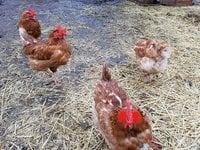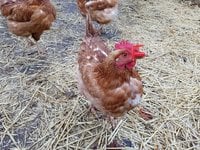Allycia
In the Brooder
- May 29, 2017
- 2
- 0
- 10
Question:
About three weeks ago one of my arucannas was severally pecked. I immediately cleaned the wound and put her in isolation. Now that the wound has completely healed I tried to reintroducing her, but have not been unsuccessful. The pecking has continued. So I did some research and came across the pin-less blinders. However, I live in Northern Illinois and this week the temps are in the negatives. Is it safe to use the blinders in such cold temps? I'm worried about their nostrils freezing. Also don't the blinders restrict their breathing?
Background:
I am a first time chicken mom. I have a small backyard flock made up of eight hens (1 barred rock, 1 buff orpington, 1 delaware, 1 new hampshire red, 2 arucanna, and 2 brown leg horns.) They are 7 months old and have been together since they hatched. They started laying right after Thanksgiving. They have a spacious coop and run (8x20) with plenty of fresh water and organic feed (New Country Organics Layer No Corn/No Soy.) I wrapped the run in plastic for the winter to protect them from the wind. I also use supplemental lighting for a few hours each day in the morning and at night.
About three weeks ago one of my arucannas was severally pecked. I immediately cleaned the wound and put her in isolation. Now that the wound has completely healed I tried to reintroducing her, but have not been unsuccessful. The pecking has continued. So I did some research and came across the pin-less blinders. However, I live in Northern Illinois and this week the temps are in the negatives. Is it safe to use the blinders in such cold temps? I'm worried about their nostrils freezing. Also don't the blinders restrict their breathing?
Background:
I am a first time chicken mom. I have a small backyard flock made up of eight hens (1 barred rock, 1 buff orpington, 1 delaware, 1 new hampshire red, 2 arucanna, and 2 brown leg horns.) They are 7 months old and have been together since they hatched. They started laying right after Thanksgiving. They have a spacious coop and run (8x20) with plenty of fresh water and organic feed (New Country Organics Layer No Corn/No Soy.) I wrapped the run in plastic for the winter to protect them from the wind. I also use supplemental lighting for a few hours each day in the morning and at night.





